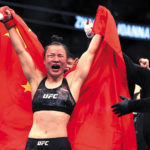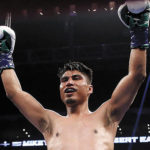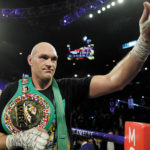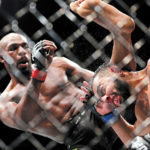UFC’s tiny logo change a big deal for new visual look
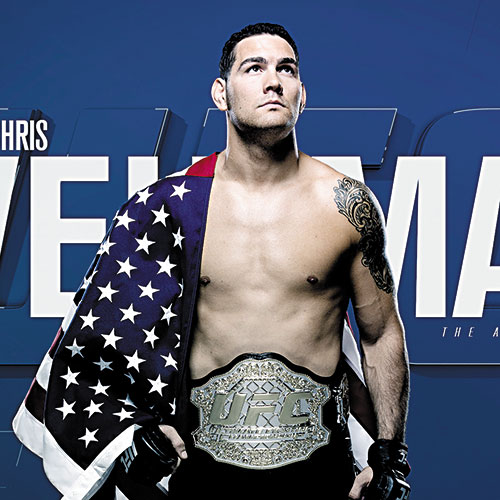
By GREG BEACHAM | AP Sports Writer
LOS ANGELES (AP) — Gil Haslam and Seton Kim realize most of their fellow mixed martial arts fans won’t notice the minor revolution in the last letter of the UFC’s redesigned logo.
The change is almost imperceptible, but look closely: The “C’” no longer looks like a wrench. From a designer’s perspective, it’s more fluid, more balanced, more professional — even to people who don’t see the difference at first.
Haslam and Kim, two veteran creative directors at Hollywood branding firm Troika, were still wary when UFC President Dana White and the mixed martial arts promotion’s top brass recently got their first look at the proposed alteration to the company’s primary logo.
“It becomes personal,” Haslam said. “We hoped that nobody on the team had the UFC logo tattooed on their body.”
The designers could breathe easily. White loved the new logo and just about everything else proposed by Troika and its UFC counterparts. They’ve spent much of this year working on a comprehensive reimagining of the mixed martial arts promotion’s visual presentation to the world, and they’re ready to unveil it this weekend at UFC 189 in Las Vegas.
“We took it to Dana, and Dana said, ‘I don’t think I can look at our current logo anymore,’” said Heidi Noland, the UFC’s vice president of global brand creative. “That never happens.”
The UFC is undergoing major changes this summer, and the ballyhooed Reebok fighter uniforms aren’t the only new look debuting Saturday.
Along with a comprehensive drug-testing program and plans for a large new headquarters in its hometown, the UFC is subtly altering everything from its logo to its fight posters to its television broadcast graphics with the help of a design company that is pushing simplicity into a famously anarchic corner of the sports world.
While Reebok’s uniforms and accompanying gear haven’t exactly been warmly received by some fans, Troika has nothing to do with them — and its comprehensive project contains nothing likely to be nearly as divisive.
Instead, the agency that has worked with most of the top American sports broadcasting entities got together with the UFC’s brand executives to bring some sort of aesthetic cohesion to a company putting on more than 40 fight cards on five continents this year.
The assignment was a thrill for Kim, an MMA fan from the sport’s earliest days.
“I would call this organization a unicorn for us,” Kim said. “Because they said, ‘Let’s not do what everybody else is doing. We’re unlike every other sport, so why are we chasing everybody else? Let’s define who we are on our own terms.’ That’s what was so incredibly exciting to me, to be able to change the game.”
The logo change was important to Haslam and Kim, but also worrisome. The UFC lettering has become ubiquitous, and the designers had no intention of abandoning it entirely — but that “C” is positively troubling to people obsessed with the finest points of typography.
“It just wasn’t as sporty or as clean as it could be,” Haslam said. “It was just a question of how far we could evolve it. We want the fans to feel the difference, but not feel like it’s something brand-new, because it didn’t need to be brand-new.”
Most of the changes are similarly subtle — putting the fight date in the same spot on every poster for every event, for instance, or using exclusively gold imagery when promoting a championship fight. The UFC’s telecasts, which the promotion zealously controls, will feature tweaks such as sprucing up the fight clock and moving it from a low corner to the bottom center of the screen.
Their creators believe the cumulative effect will make the UFC more fun to watch for hardcore enthusiasts and less confusing for casual fans.
“Everything that we’re doing is to help connect the sport with our audience,” said Jackie Poriadjian, the UFC’s senior vice president of global brand marketing. “We’re more focused on athlete development now, and we’ve brought in (UFC drug testing czar) Jeff Novitzky. Everything ladders up into that athlete-first philosophy that’s the core of our sport.”
These changes were probably overdue for a company that grew from a fly-by-night fight promotion into a worldwide entertainment brand in less than two decades.
After White and his partners bought the UFC in 2001, they concentrated on building the company and its renegade product into a legitimate sports organization. With the UFC deep into its next phase of worldwide expansion, its new design plan covers almost every aspect of its sprawling existence.
Roughly 30 people worked on the complicated project over the last six months, and they’ll unveil much of that work this weekend. From the connected logos for every UFC program to the cleaned-up look of the Fight Pass website, the UFC says all of this work outside the octagon is designed to spotlight what happens inside the cage.
“It doesn’t mean we’ve gone more corporate or more conservative, or that we want to be like anything else out there,” Noland said. “We just want to embrace our DNA. This isn’t a rebrand, to be honest. It isn’t reinventing ourselves. It’s really just presenting what the UFC is in its best form.”







